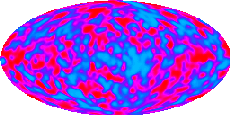|
1. 2.
2.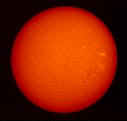 3.
3.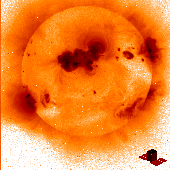 |
| Here
are 3 images of our nearest star, the sun. Why do you think they look so
different? What do you think they show? Each one is made with
different type of light: 1. extreme ultraviolet, 2. visible, and 3. x-ray.
All these images were made by telescopes orbiting the Earth in satellites. |
|
 4. 4.

|
4. If
you looked at the planet Jupiter through a good-sized optical telescope above the
Earth's atmosphere, it might look like this color-corrected image. |
| 5. But another type of
telescope, at the NASA Infrared Telescope Facility (IRTF) in Hawaii, made
these images of Jupiter: Why didn't we see the rings before?. What does
infrared mean?
6. This infrared image shows the impact sites
of several pieces of the comet Shoemaker-Levy 9, which bombarded Jupiter
with its fragments after breaking up in the giant planet's gravitational field in 1994. The
impact sites are white because the are locations of intense infrared
radiation (infrared = "heat" to you and me).
|
5.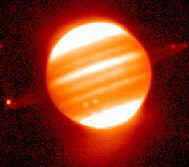
6. |
|
7. 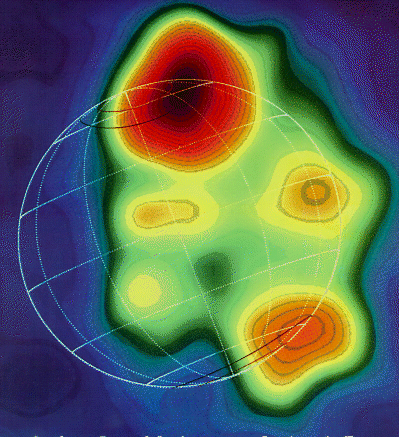 |
7. Still another
telescope, on board a satellite called ROSAT, made this image of Jupiter after some of
the Shoemaker-Levy fragment impacts. This is a false-color x-ray image.
The black and red spots are emitting fewer x-rays than the green or yellow
areas.
|
 8.
Volcanic eruptions on Io in visible light. Io is one of the
moons of Jupiter and is known as the most volcanically active object in our
solar system. Io was discovered 8.
Volcanic eruptions on Io in visible light. Io is one of the
moons of Jupiter and is known as the most volcanically active object in our
solar system. Io was discovered by the scientists Galileo and Marius in 1610 (more than 300 years ago!) by the scientists Galileo and Marius in 1610 (more than 300 years ago!)
|
9. 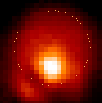 10. 10.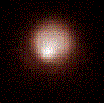 |
 9,10.Two infrared images of a volcanic eruption on Io - one of Jupiter's moons. The second image, taken seven days after the first image, reveals that the eruption has decreased in intensity. 9,10.Two infrared images of a volcanic eruption on Io - one of Jupiter's moons. The second image, taken seven days after the first image, reveals that the eruption has decreased in intensity. |
|
11. At right we have a false color image of Comet B2
Hyakutake from NASA's
Extreme Ultraviolet Explorer
(EUVE) satellite. Various types of light can be "selected" by having light pass
through a metal or plastic foil filter. The light for this image
passed through a filter which allows only light with wavelengths of 70-90
Angstroms to go through.
|
11.
|
|
  12.
12.
|
12. Because it has no atmosphere to absorb these wavelengths,
the moon can reflect Extreme Ultraviolet light. Where do you think the EUV
light in our solar system comes from?
|
13. This is a very dense
star cluster near the center of our galaxy. In a few million years,
gravitational forces will tear it apart, but for now it contains some of the most
luminous stars in the galaxy. Yet, this cluster is not visible because of
dust near the galactic center. How was this picture taken? In x-rays?
UV? the center of our galaxy. In a few million years,
gravitational forces will tear it apart, but for now it contains some of the most
luminous stars in the galaxy. Yet, this cluster is not visible because of
dust near the galactic center. How was this picture taken? In x-rays?
UV? |
 |
|
14. 
14. Near infrared light from the
central disk of the Milky Way. Most of the emission at these wavelengths is
from relatively cool giant stars in the disk and bulge of the Milky Way.
Interstellar dust does not strongly absorb these wavelengths. |
15,16.
Two images showing parts of the center of our galaxy in x-ray wavelengths at different
resolutions. 
15.
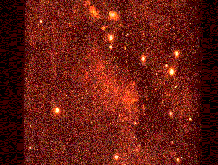
|
|
16. Why do you think they are different colors?

|
|
17. In
visible light, most of the disk of the galaxy is obscured by dust.

|
18. But the center
of the galaxy appears quite bright (red) in this
gamma ray image.

|
|
| |
|

| 19.
Radio wave image showing an Arc at the Galactic Center. |
|
This image shows the spiral galaxy NGC 4736, seen through an ultraviolet
filter on top with a visible light image on the bottom. Click the
image for a bigger, more detailed version. |
 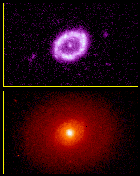
|
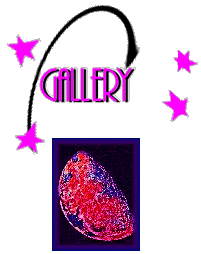 of Astronomical Images.
of Astronomical Images.

